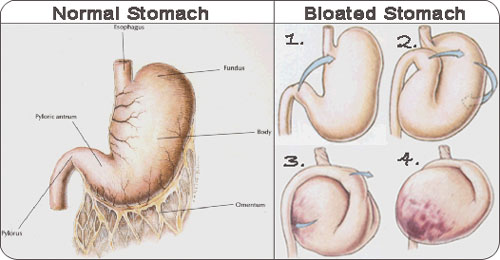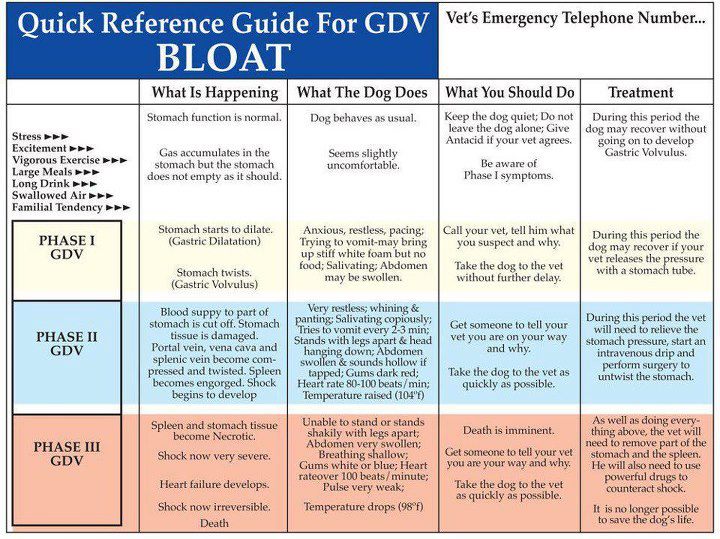A condition most frequent in, but not restricted to, large and giant breeds. The stomach fills with gas and rather than expelling it as normal, the gut twists and flips over on itself cutting off the blood supply and results in the tissue dying, often with fatal consequences for the host.
Because this topic is such a serious one and one which many people do panic about, I’ve attached an article I came across on the subject which is well worth a read and may clarify things for you.
For the most part, symptoms are report as coming on very quickly and deteriorating with alarming speed. However, in a few instances it has been a “slow bloat” rather than the usual rapid bloat. For this reason, if you feel that your dog is NOT HIMSELF or OUT OF SORTS for a couple of days, there is an outside chance that this could be the start of bloat. In all instances, keep your eye on his breathing rate, heart rate and gum colour and if you are unhappy that any of these three things is out of the ordinary, PLEASE SEE YOUR VET as a matter of urgency.
Although difficult to answer the common question of Why did it happen to my dog? there are a variety of risk factors:
Typically occurs in large chested breeds such as Great Danes, German Shepherds, Doberman Pinschers, Flat Coated Retrievers but Bloat can occur in any breed including Rhodesian Ridgebacks, as well as Dachshunds, Labrador Retrievers etc
Other causes are activity in relation to meal times which is why you should feed your dogs at least an hour before exercise and preferably the same on return.
Elevated food bowls (May need to change that one as opinions are now changing!)
Rapid Eating
Too much water directly before, or after, meals
The list is long! Some studies show a hereditary effect from a first degree relative and stress is also thought to be a factor. Certain medical conditions also increase the risk as well as the X-factor – the unknown or idiopathic.
So what are the symptoms?
Again the list is long but the most common and obvious signs to watch out for:
Quiet, unusual behaviour
Salivating
Restless and appears uncomfortable
Usually refuses food, not on the agenda for many RR’s I suspect!
Abdomen appears full
May try to retch or vomit, typically unproductively
Shallow panting/rapid breathing
Abdomen becomes grossly enlarged and when tapped is like a drum
Ultimately the dog will collapse, feet and ears will feel cold (shock) and the gums may cease to be a healthy pink
Don’t let it get this far… if you suspect Bloat, call your Vet immediately and be prepared to transport the patient to make sure help is at hand including a heavy blanket or something that can be used as a stretcher if required.
This is where every animal owner should be familiar with their veterinary practice’s arrangements for emergencies, particularly for out of hours cover, although you should await instructions before setting off. In the meantime avoid unnecessary cooling and try to give the patient room to stretch out. If possible take someone to help and remain contactable.
Bloat often occurs within two hours of feeding, more at night than day, symptoms progress over 1-2 hours and early intervention improves prognosis so as a rule of thumb: veterinary attention within one hour of significant symptoms is suggested.
Once you reach the vet, as time is critical, it is important to assess the situation and plan. Diagnostic tests may be required: X-ray, blood tests and Ultra Sound Scanning.
One of the most important things, as an animal owner, is to choose a Vet that you like, respect and trust. One where you can ask questions (there’s no such thing as a stupid question!!) and strive for a mutually respectful relationship where you can work together in the interests of your beloved pets. (Oh am I a lucky girl here!). This will help you make a decision, sometimes a difficult one, as treatment may not always be the best option but failure to treat or euthanase a true GDV is a serious welfare issue.
Having said this – if dealt with promptly the prognosis for GDV is generally fair to good.
Treatment Objectives should be:
Decompress the Stomach
Correct the Rotation
Maintain Circulation
Identify and remove necrotic (dead) tissue
Fix/staple stomach in correct location (gastropexy) to avoid recurrence
Provide Post-Operative care
The outcome is always uncertain but probabilities can be estimated depending on the duration of the symptoms and the severity of the clinical signs.
Blood Lactate levels <6 are better, Blood Lactate levels >6 are worse.
Plasma Lactate concentration as a predictor of gastric necrosis and survival among dogs with gastric dilatation – volvulus: 102 cases (1995-1998)
de Papp E, Drobatz KJ, Hughes D
J AM Vet Med Assoc 1999 July 1;215(1):49-52
From the above study, lactate can give some indication of whether gastric necrosis has occurred and gastric necrosis is a reasonable indicator of outcome. If NO gastric necrosis has occurred dogs had a greater than 90% survival rate. Even WITH some degree of gastric necrosis there was a 66% survival rate.
In broad terms it would usually be appropriate to initiate treatment and make decisions when more information is available.
Behind the scenes you would expect:
Fluids – first and fast
Possibly X-ray
Sedate/anaesthetise
Decompress if possible (intubation)
Whether, or not, decompression is successful, often the best course of action is a Laparotomy (investigative abdominal surgery) followed by appropriate action.
All dogs treated surgically for GDV should have a gastropexy
Approximately 40% of dogs require partial or complete splenectomy (spleen removal) this and gastropexy are made easier by stapling (and you thought that was just for paper but please don’t try the domestic variety!)
Approximately 10% of dogs require partial gastrectomy (stomach removal)
Survival rates can be as high as 90% but may be, predictably, much lower. Fortunately Bloat is not all that common – Wendover Heights, with circa 10 small animal vets, state they may have approximately one case per month.
I sincerely hope that few of us will ever have the experience of Bloat but should it occur, or you suspect it at any time, I trust that this synopsis will have been helpful.
Thank you
Elena Jeffery
If you are on FACEBOOK there are a couple of really good groups you may wish to join to get further information and share your experiences. One is Tails of Bloat, and the other is Canine Bloat Awareness.


